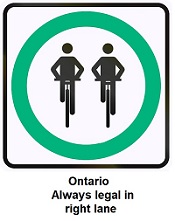ONTARIO PROVINCIAL POLICE PERSIST WITH ANTI-CYCLING MESSAGING

 The OPP's traffic patrol has a reputation on provincial roads for its hostility towards cyclists. Often its officers will cite non-existent legal requirements. OPP's latest salvo against cyclists has occurred on social media with a gross misrepresentation of Ontario's Highway Traffic Act (HTA). It started with an OPP tweet over a pictogram of cyclists being followed by motor vehicle which stated, "Under the Highway Traffic Act, cyclists shall ride single file and move to the right to allow a vehicle to pass". Understandably there was substantial blowback from cyclists who know the law far better than the legalwise illiterate responsible for OPP's social media's messaging.
The OPP's traffic patrol has a reputation on provincial roads for its hostility towards cyclists. Often its officers will cite non-existent legal requirements. OPP's latest salvo against cyclists has occurred on social media with a gross misrepresentation of Ontario's Highway Traffic Act (HTA). It started with an OPP tweet over a pictogram of cyclists being followed by motor vehicle which stated, "Under the Highway Traffic Act, cyclists shall ride single file and move to the right to allow a vehicle to pass". Understandably there was substantial blowback from cyclists who know the law far better than the legalwise illiterate responsible for OPP's social media's messaging.
Let's get this straight from the get-go. The HTA has no requirement to ride single file.
Two days later, seemingly in response to, but without acknowledging, the comments that called out the accuracy of the tweet, the OPP tweeted again. This time with a caption (also in the above link), with what looked like direct quotes from the HTA. In fact, the first listing from S.147(1) of the HTA had been edited by removal of an option which undermines the accuracy of OPP's original claim. The actual legal text of the missing option requires only that a vehicle operator, including a cyclist, drive in the right-hand lane.
 The other quote was simply an incomplete representation of the HTA.The missing legal text explicitly states that when overtaken a person is required to leave no more than half of the roadway free.
The other quote was simply an incomplete representation of the HTA.The missing legal text explicitly states that when overtaken a person is required to leave no more than half of the roadway free.
Responding to this less than transparent alteration and meaning of the law, the host of this Vehicular Cyclist website photoshopped OPP's original caption and posted it to show the actual legal texts omitted by the OPP's in their tweet. (See left.)
Shame on you OPP. You are behaving unethically and irresponsibly. It's time to re-educate yourself and refocus your messaging to aim it at those motorists you are encouraging to act aggressively towards vulnerable road users. You could start by adopting our slogan. "Slow down, be patient, and wait till it's safe to pass"
Posted July 15, 2021.
NEGATIVE POLICE INVOLVEMENT IN CYCLIST BULLYING CASE
 Fed-up with dangerous and illegal close passing by motorists, London, Ontario cyclist, Joy Cameron decided to start "taking the lane". Any cyclist (including the writer) who practices this self-preservation technique has suffered the angry wrath of aggressive drivers who inevitably honk their horns in a threatening manner as a signal to get out of their way. This happened and worse to Cameron. She not only was the target of the expected honking, but the motorist followed her closely behind around her neighborhood.
Fed-up with dangerous and illegal close passing by motorists, London, Ontario cyclist, Joy Cameron decided to start "taking the lane". Any cyclist (including the writer) who practices this self-preservation technique has suffered the angry wrath of aggressive drivers who inevitably honk their horns in a threatening manner as a signal to get out of their way. This happened and worse to Cameron. She not only was the target of the expected honking, but the motorist followed her closely behind around her neighborhood.
Another cyclist witnessed what happened and after talking to Cameron, called the London Police. Astonishingly, a day later a police officer called to warn Cameron that she should be riding at the far edge of the road - a risky practice avoided by experienced cyclists because to some motorists it's viewed as an opportunity to squeeze past.
See reports on Twitter and on CBC's website
It should be noted that the CBC London reporter mentions that Ontario's Highway Traffic Act is "somewhat ambiguous". However when S.147(1) Slow vehicles to travel on right side is read in full it is clear there is no ambiguity in law. One of two options are offered to a person driving a slow vehicle (bike or motor vehicle). The single option presented in the report is to drive at the far edge of the road. Not mentioned is another option, one motorists all do when being passed without thinking - to drive in the right-hand lane. The sole "get-out-of-my-way" requirement is a common myth promulgated in media by the Ministry of Transport of Ontario, the OPP, and other Ontario police services. It's gladly picked up as a fact by too many motorists whose hate for cyclists riding legally can turn into threatening behavior and violence. This has to stop.
Posted July 15, 2021
MYTHBUSTING
 SUBSCRIBE
SUBSCRIBE
 SUBSCRIBE
SUBSCRIBE